https://www.philahomeopathy.com/copd-homeopathic-treatment/
Treatment for COPD
Treatment for COPD can ease symptoms, prevent complications, and generally slow disease progression. Your healthcare team may include a lung specialist (pulmonologist) and physical and respiratory therapists.
Below are the most common western treatments for COPD
Oxygen therapy – a vital component of any treatment for COPD
If your blood oxygen level is too low, you can receive supplemental oxygen through a mask or nasal cannula to help you breathe better. A portable unit can make it easier to get around.
Medications for COPD – most popular in western medicine treatment for COPD
Pharmaceutical medications are another type of treatment for COPD that can reduce symptoms and cut down on flare-ups. It may take some trial and error to find the medication and dosage that works best for you, but these are some of your options:
Inhaled bronchodilators
Medicines are called bronchodilators to help loosen tight muscles in your airways. They’re typically taken through an inhaler or nebulizer. Short-acting bronchodilators last from 4 to 6 hours. You only use them when you need them. For ongoing symptoms, there are long-acting versions you can use every day. They last about 12 hours.
Corticosteroids
Long-acting bronchodilators are commonly combined with inhaled glucocorticosteroids. A glucocorticosteroid can reduce inflammation in the airways and lower mucus production. The long-acting bronchodilator can relax the airway muscle to help the airways stay wider. Corticosteroids are also available in pill form.
Phosphodiesterase-4 inhibitors
Phosphodiesterase-4 inhibitors are a type of medication that can be taken in pill form to help reduce inflammation and relax the airways. It’s generally prescribed for severe COPD with chronic bronchitis.
Theophylline
This medication eases chest tightness and shortness of breath. It may also help prevent flare-ups. It’s available in pill form. Theophylline is an older medication that relaxes the muscle of the airways, and it may cause side effects. It’s generally not a first-line treatment for COPD
Surgery – treatment for COPD used in cases when other conservative approaches failed.

Surgery is reserved for severe COPD or when other treatments have failed, which is more likely when you have a form of severe emphysema.
One type of surgery is called bullectomy. During this procedure, surgeons remove large, abnormal air spaces (bullae) from the lungs.
Another is lung volume reduction surgery, which removes damaged upper lung tissue. Lung volume reduction surgery can be effective at improving breathing, but few patients undergo this major, somewhat risky procedure.
Lung transplantation is an option in some cases. Lung transplantation can effectively cure COPD but has its many risks.
There is a less invasive method of improving the efficiency of airflow in people with severe emphysema called endobronchial valves (EBV), which are one-way valves that divert inspired air to healthy lungs and away from non-functioning, damaged lungs.
What is COPD?
COPD is an acronym for Chronic Obstructive Pulmonary Disorder. As the name implies, it is a disorder of the respiratory system that impairs breathing due to blockage of the respiratory system over a long period of time. Asthma is another chronic respiratory condition that causes a blockage of the airways. However, one major difference between asthma and COPD is that while the blockage caused by asthma is completely reversible (not curable) by medications, the blockage caused by Chronic Obstructive Pulmonary Disorder is not completely reversible. Another difference is that asthma is a type of allergic reaction and is related to allergies. It can be triggered by allergenic substances like dust and pollens. COPD, on the other hand, is triggered by continuous inhaling of irritants like smoke, tar, and soot. Asthma is not really preventable – it is in the genes – it is only manageable. COPD is preventable. COPD is more common than you may think – it is so common to the extent that it was once thought of as the fourth leading cause of death in the United States of America. COPD is an umbrella term for two chronic diseases – emphysema and chronic bronchitis. Chronic bronchitis happens when there is too much secretion of mucus in the airways over a long period. It could last for more than 3 months each year for at least two years. Emphysema is damage to some structures in the lungs as a result of the blocked airways. This damage makes the blocked airways worse. In a person suffering from COPD, features of both emphysema and chronic bronchitis are usually seen. There is one major factor that can contribute to chronic obstructive pulmonary disorder – cigarette smoking (not hard to see where the label “smokers are liable to die young” came from). Other factors include inhaling toxic dust and chemicals and air pollution.
However, one major difference between asthma and COPD is that while the blockage caused by asthma is completely reversible (not curable) by medications, the blockage caused by Chronic Obstructive Pulmonary Disorder is not completely reversible. Another difference is that asthma is a type of allergic reaction and is related to allergies. It can be triggered by allergenic substances like dust and pollens. COPD, on the other hand, is triggered by continuous inhaling of irritants like smoke, tar, and soot. Asthma is not really preventable – it is in the genes – it is only manageable. COPD is preventable. COPD is more common than you may think – it is so common to the extent that it was once thought of as the fourth leading cause of death in the United States of America. COPD is an umbrella term for two chronic diseases – emphysema and chronic bronchitis. Chronic bronchitis happens when there is too much secretion of mucus in the airways over a long period. It could last for more than 3 months each year for at least two years. Emphysema is damage to some structures in the lungs as a result of the blocked airways. This damage makes the blocked airways worse. In a person suffering from COPD, features of both emphysema and chronic bronchitis are usually seen. There is one major factor that can contribute to chronic obstructive pulmonary disorder – cigarette smoking (not hard to see where the label “smokers are liable to die young” came from). Other factors include inhaling toxic dust and chemicals and air pollution.
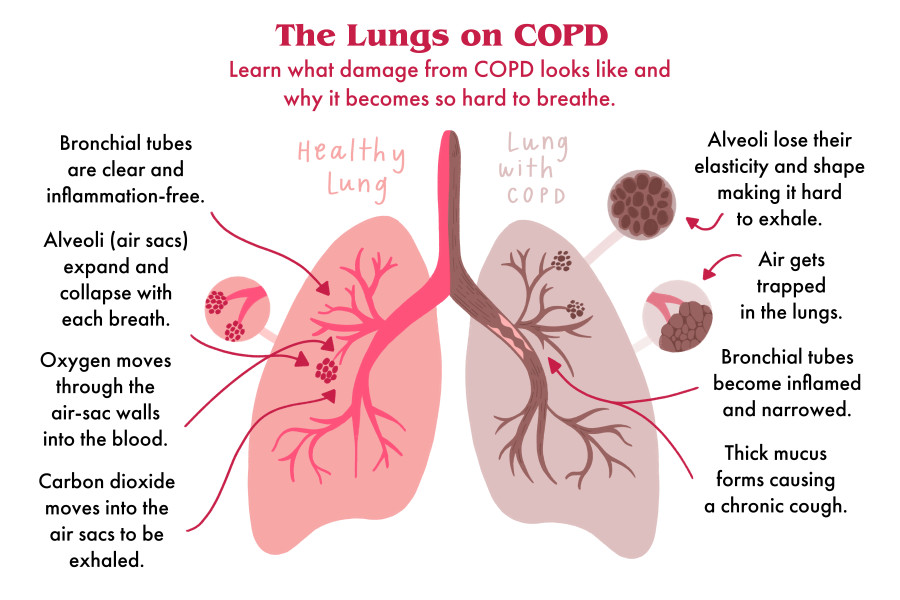
COPD refers to a group of diseases that cause breathing problems and blockages in airflow. They gradually get worse over time.
Chronic obstructive pulmonary disease (COPD) is estimated to affect 32 million persons in the United States and is the third leading cause of death in this country. [1] Patients typically have symptoms of chronic bronchitis and emphysema, but the classic triad also includes asthma.
COPD is more common in:
- Females, although it is important to note that female smokers are about 50% more likely to develop COPD than men. Also, females with severe COPD have a higher risk of hospitalization and death from respiratory failure.
- People with a history of asthma
- Individuals aged 65 years and older
- Current or former smokers
A person’s windpipe connects to the lungs, where it divides into many smaller branches. These branches end in small air sacs called alveoli, which have tiny blood vessels known as capillaries running along their walls. Here, oxygen passes from the sacs into the capillaries, and the waste product carbon dioxide passes from the capillaries into the sacs. Breathing involves this exchange of gases.
In someone with healthy lungs, the airways and air sacs are stretchy. This elasticity permits the sacs to inflate when a person breathes in and deflate when they breathe out.
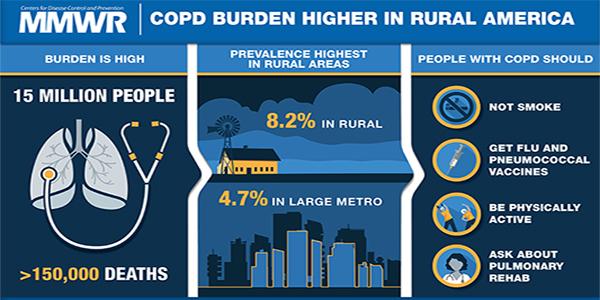
People with COPD have less air going in and out of their airways because of one or more of the following:
- The airways and sacs become too compliant, especially in emphysema, and lose their elastic recoil, leading to alveolar destruction.
- The airway walls become thick and inflamed in a manner similar to chronic bronchitis.
- The airways produce more mucus, which clogs airflow, as seen in people with asthma. Untreated, COPD can lead to a faster progression of the disease, heart problems, and worsening respiratory infections.
What are the causes of COPD?
Most people with COPD are at least 40 years old and have at least some history of smoking. The longer and more tobacco products you smoke, the greater your risk of COPD is.
In addition to cigarette smoke, cigar smoke, pipe smoke, and secondhand smoke are one of the many causes of COPD. Your risk of COPD is even greater if you have asthma and smoke.

Other causes of COPD are:
- You can also develop COPD if you’re exposed to chemicals and fumes in the workplace. Long-term exposure to air pollution and inhaling dust can also cause COPD.
- In developing countries, along with tobacco smoke, homes are often poorly ventilated, forcing families to breathe fumes from burning fuel used for cooking and heating.
- There may be a genetic predisposition to developing COPD. Up to an estimated 5 percent of people with COPD have a deficiency in a protein called alpha-1-antitrypsin. This deficiency causes the lungs to deteriorate and also can affect the liver. There may be other associated genetic factors at play as well.
Types of COPD
The two main types of COPD are emphysema and chronic bronchitis, but many individuals with COPD can have both.
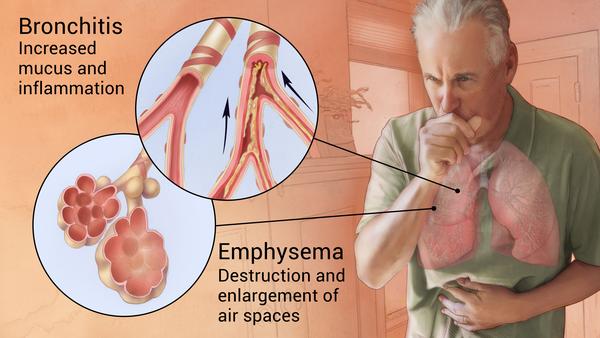
Emphysema
In emphysema, the alveoli, which are the walls of the air sacs, and the small airways suffer damage. As a result of this damage, the sacs lose their shape and ability to recoil during the expiratory phase of the breathing cycle, resulting in trapped air in the lung. This trapped air continues to distend the alveoli, causing a repeating cycle of airway obstruction.
These changes eventually result in the lungs becoming hyperinflated, which reduces the exchange of gases. This makes it difficult for people to breathe and oxygenate their blood effectively while impairing the ability to breathe out carbon dioxide from the blood.
Chronic bronchitis
In chronic bronchitis, the lining of the airways stays inflamed. This leads to swelling and the formation of large amounts of mucus. These effects make it hard to breathe.
Symptoms of COPD
Symptoms of COPD may be mild at first, beginning with intermittent coughing and shortness of breath. As it progresses, symptoms can become more constant to where it can become increasingly difficult to breathe.
You may experience wheezing and tightness in the chest or have excess sputum production. Some people with COPD have acute exacerbations, which are flare-ups of severe symptoms.
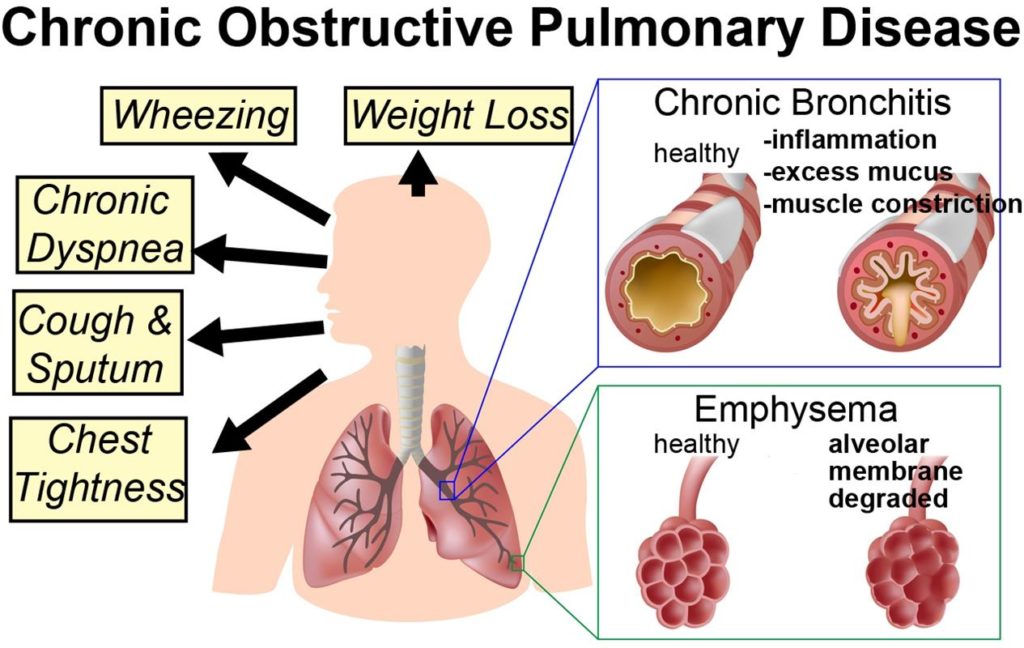
Early symptoms of COPD
At first, symptoms of COPD can be quite mild. You might mistake them for a cold.
Early symptoms include:
- Occasional shortness of breath, especially after exercise
- Mild but recurrent cough
- Needing to clear your throat often, especially first thing in the morning
- You might start making subtle changes, such as avoiding stairs and skipping physical activities.
Worsening symptoms of COPD
Symptoms can get progressively worse and harder to ignore. As the lungs become more damaged, you may experience:
- Shortness of breath, after even mild forms of exercise like walking up a flight of stairs
- Wheezing, which is a type of higher-pitched noisy breathing, especially during exhalations
- Chest tightness
- Chronic cough, with or without mucus
- Need to clear mucus from your lungs every day
- Frequent colds, flu, or other respiratory infections
- Lack of energy
In later stages symptoms of COPD may also include:
- Fatigue
- Swelling of the feet, ankles, or legs
- Weight loss
Symptoms of COPD are likely to be much worse if you currently smoke or are regularly exposed to secondhand smoke.
How do doctors diagnose and treat COPD?
There are four major considerations when a medical practitioner diagnosing Chronic Obstructive Pulmonary Disorder. These considerations include:
- breathlessness that is persistent and worsens over time;
- a chronic cough (over 3 months of coughing);
- overproduction of sputum for a long period of time;
- history of smoking or exposure to dust, chemicals, and
There may be wheezing and tightness of the chest in addition to this. Doctors may have to do some tests to make sure that it is COPD and not another disease that can mimic COPD like pneumonia. The phrase “prevention is better than cure” applies strongly to COPD as there is no cure it is best prevented. It should be noted that the best and most effective step to manage COPD is to stop exposure to all irritants –, especially cigarettes. Smoking cessation is the most scientifically recognized method of managing Chronic Obstructive Pulmonary Disorder. However, doctors can manage this condition with medications like Ventolin which helps open up the airways, ambroxol to break down phlegm/mucus, ipratropium to reduce the secretion of mucus, and steroids like fluticasone to reduce swelling in the airways. They can be used in combinations to increase effectiveness. This is by no means an exhaustive list of medications, however.
Natural Treatment for COPD
Natural Treatment for COPD is another treatment for COPD that has been proven to be effective and it helps reduce the symptoms of COPD with little to no side effects.
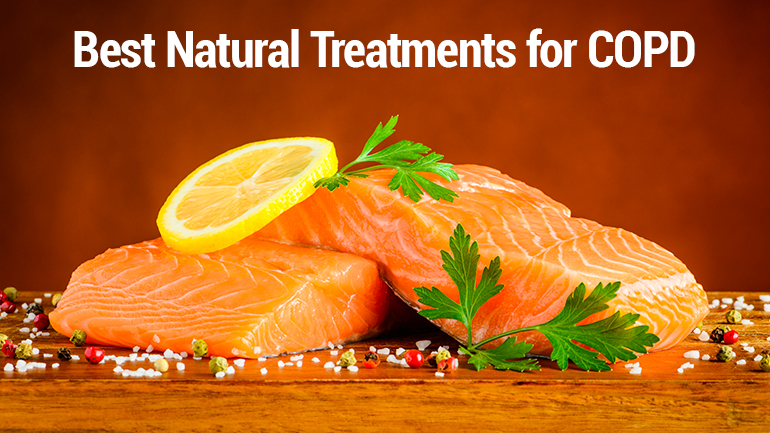
Below are the most common techniques used for the natural treatment of COPD:
Home remedies for COPD – most common form of natural treatment for COPD
Home remedies for COPD are representing one of the most common approaches to natural treatments for COPD that can ease COPD symptoms with ease at home.
Below are the most popular home remedies for COPD
Avoiding smoking and vaping
Cigarette smoke exposes your lungs to an irritant that causes physical damage. This is why smokers often develop COPD. Smoking is responsible for 8 out of every 10 deaths due to COPD. Smoking is the main cause of COPD and most people with COPD either smoke or is used to smoke. Breathing in lung irritants other than cigarette smoke — such as chemical fumes, dust, or air pollution — can also cause COPD.
Staying active
Because COPD causes shortness of breath, it can be hard to stay active. Increasing your fitness levels can actually help symptoms such as shortness of breath. However, exercise for COPD such as walking, jogging, and biking can be challenging with COPD. One study found that water-based exercise for COPD, such as aqua walking and swimming, is easier with COPD and can improve fitness and quality of life. Other studies on alternative forms of exercise for COPD have suggested that yoga and tai chi also can be beneficial to people with COPD by improving lung function and exercise tolerance. Get more tips on staying fit when you have COPD.
Essential oils for COPD – effective form of treatment for COPD
Many people turn to essential oils for COPD to help their symptoms. Essential oils for COPD are one of the home remedies for COPD that is also effective. However, as with any supplement, ask your doctor before using essential oils for COPD.
Breathing exercises – a vital component of natural treatment for COPD
Research shows that breathing exercises for COPD can help people with COPD by decreasing breathlessness, improving quality of life, and decreasing fatigue. The two main types of breathing techniques recommended for people with COPD are pursed-lip and diaphragmatic breathing. They help people with COPD get air without struggling to breathe.

Breathing exercises for COPD include:
- Pursed-lip breathing. This is when a person inhales through their nose and exhales through tightly pursed lips.
- Diaphragm breathing. This means contracting the diaphragm in order to breathe more deeply. The belly visibly expands while breathing in, and it deflates when breathing out.
- This is a controlled breathing technique common in yoga practice. Pranayama involves concentrating on areas of the body involved in breathing.
Diet for COPD – an essential part of any treatment for COPD
Diet for COPD is a home remedy for COPD that can help prevent or manage some of the adverse health effects of COPD, a lung condition characterized by airflow limitation that makes it hard to breathe.
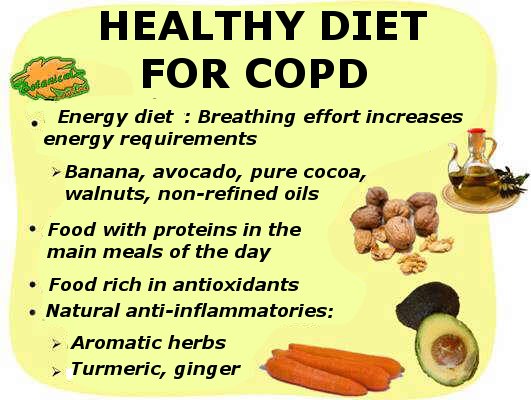
According to research, a healthful, well-balanced diet for COPD can have the following beneficial health effects in people with COPD:
- Reducing inflammation
- Maintaining and improving muscle strength
- Improving lung function
- Lowering metabolic and heart disease risk
Herbal medications for COPD – an effective and safe natural treatment for COPD
Some herbal treatments can be used to improve conditions of COPD and help manage breathlessness. Some studies have been done on Chinese-based herbal medicines. Some of these medicines include Radix Scutellariae (Huang Qin), Herba Ephedra (Ma Huang), Semen Persicae (Tao Ren), Radix Ginseng (Ren Shen), Fructus Schisandrae (Wu Wei Zi), and Rhizoma Atractylodis Macrocephalae (Bai Zhu). Radix Scutellariae (Huang Qin), Herba Ephedra (Ma Huang), and Semen Persicae (Tao Ren) are used more for acute exacerbations of Chronic Obstructive Pulmonary Disorder where COPD suddenly gets worse or develops complications, while Fructus Schisandrae (Wu Wei Zi), Radix Ginseng (Ren Shen), and Rhizoma Atractylodis Macrocephalae (Bai Zhu) are used for COPD.

From the perspective of Chinese traditional medicine, herbs like Semen Armeniacae Amarum (Xin Ren) and Fructus Perillae (Zi Su Zi) are used to reduce excessive mucus production traditionally. Radix ginseng is believed to arrest stubborn persistent cough.
Studies on these herbs suggest that some of them work in a similar manner to orthodox medicines. The Chinese herbs – Semen Armeniacae Amarum (Xin Ren), Herba Ephedra (Ma Huang), Fructus Perillae (Zi Su Zi), and Radix Astragali (Huang Qi) most likely work in a similar manner to steroids like fluticasone. They work on the immune system and reduce inflammation in the lungs which helps improve breathing. Amygdalin which is one of the active components of Semen Armeniacae Amarum (Xin Ren) according to some studies may act in a similar manner as salbutamol. However, more studies are needed to verify that.
The use of herbs for COPD is another approach to natural treatment for COPD that causes little or no side effects.
Below are the most commonly used herbal treatments for COPD
English Ivy (Hedera Helix)
- This herbal Treatment for COPD may offer relief from airway restriction and impaired lung function associated with COPD.
- Curcumin is a herb for COPD that is commonly found in turmeric (Curcuma longa). Turmeric is a spice commonly used in curries. Long used in traditional Asian medicine, curcumin has been shown to reduce airway inflammation.
Red Sage (Salvia Miltiorrhiza)
- Red sage is an effective antioxidant, protecting the linings of blood vessels from injury when oxygen is temporarily cut off and then resumed, as in the case of COPD exacerbations.
Acupuncture – an ancient Chinese natural treatment for COPD
Acupuncture for COPD is a natural treatment for COPD that has been proven to help reduce the symptoms of COPD.

Acupuncture, an important part of traditional Chinese Medicine, has been used for thousands of years in treating many painful and non-painful conditions. To date, it has become popular and widely practiced in many countries around the world.
It is reported that Acupuncture for COPD may help relieve COPD by reducing bronchial immune-mediated inflammation and by promoting the release of vascular and immunomodulatory factors.
Homeopathy – #1 natural treatment for COPD
Homeopathic medicines can make a great combination with orthodox medicines or are worth a try in the treatment of chronic obstructive pulmonary disorders.

Although they are given based on principles of “like cures like”, and scientific proof on their effectiveness in COPD is increasing. Homeopathic medications may provide a much more natural and organic way in the treatment of COPD.
Some homeopathic remedies that can be used for COPD include:
Aspidosperma Q: this is one of the best therapies for COPD it is a tonic for the lungs. It is very good in situations where breathlessness is worse with exercise or physical activity which is very common in people with COPD.

Naphthalene 30 is used for difficulty breathing (dyspnea) and emphysema. It is suitable where there are a severe cough and production of copious amounts of mucus. Antimonium tart 30 and Antimonium Ars 30 are also useful for this kind of condition.
Curare 6 is used where there is shortness of breath. It is very useful in sleep apnea (blockage of the respiratory tract during sleep) and other respiratory problems like disturbing dry cough and breathlessness.
Senega 30, and Strychninum 30 are useful when a cough is persistent, comes with chest pain, and there are respiratory issues like breathlessness
Other homeopathic medications used to treat COPD include Bryonia alba for dry coughs and pressure in the chest, Phosphorus, Sulphur, and Calcarea Carbonica.
Treatment for COPD in Philadelphia
Homeopathic medicines can make a great combination with orthodox medicines or are worth a try in the treatment of chronic obstructive pulmonary disorders. Although they are given based on principles of Chinese medicine, scientific proof on their effectiveness in COPD is increasing. Homeopathic medications may provide a much more natural and organic way in the treatment of COPD.
At the Philadelphia Homeopathic Clinic, Dr. Tsan treats COPD using homeopathic remedies individually selected for each patient based on symptoms, generalities, and a person’s constitution.

To book your appointment for homeopathic evaluation contact us by calling (267) 403-3085 or use our online scheduling system.
Comments
Post a Comment